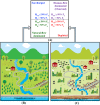Quantifying Anthropogenic Stress on Groundwater Resources
- PMID: 29018217
- PMCID: PMC5635107
- DOI: 10.1038/s41598-017-12877-4
Quantifying Anthropogenic Stress on Groundwater Resources
Abstract
This study explores a general framework for quantifying anthropogenic influences on groundwater budget based on normalized human outflow (hout) and inflow (hin). The framework is useful for sustainability assessment of groundwater systems and allows investigating the effects of different human water abstraction scenarios on the overall aquifer regime (e.g., depleted, natural flow-dominated, and human flow-dominated). We apply this approach to selected regions in the USA, Germany and Iran to evaluate the current aquifer regime. We subsequently present two scenarios of changes in human water withdrawals and return flow to the system (individually and combined). Results show that approximately one-third of the selected aquifers in the USA, and half of the selected aquifers in Iran are dominated by human activities, while the selected aquifers in Germany are natural flow-dominated. The scenario analysis results also show that reduced human withdrawals could help with regime change in some aquifers. For instance, in two of the selected USA aquifers, a decrease in anthropogenic influences by ~20% may change the condition of depleted regime to natural flow-dominated regime. We specifically highlight a trending threat to the sustainability of groundwater in northwest Iran and California, and the need for more careful assessment and monitoring practices as well as strict regulations to mitigate the negative impacts of groundwater overexploitation.
Conflict of interest statement
The authors declare that they have no competing interests.
Figures






References
-
- Wada Y, van Beek LPH, Bierkens MFP. Modelling global water stress of the recent past: on the relative importance of trends in water demand and climate variability. Hydrol. Earth Syst. Sci. 2011;15:3785–3808. doi: 10.5194/hess-15-3785-2011. - DOI
-
- Hagemann S, et al. Climate change impact on available water resources obtained using multiple global climate and hydrology models. Earth Syst. Dyn. 2013;4:129–144. doi: 10.5194/esd-4-129-2013. - DOI
-
- Wu P, Christidis N, Stott P. Anthropogenic impact on Earth’s hydrological cycle. Nat. Clim. Change. 2013;3:807–810. doi: 10.1038/nclimate1932. - DOI
Publication types
LinkOut - more resources
Full Text Sources
Other Literature Sources

